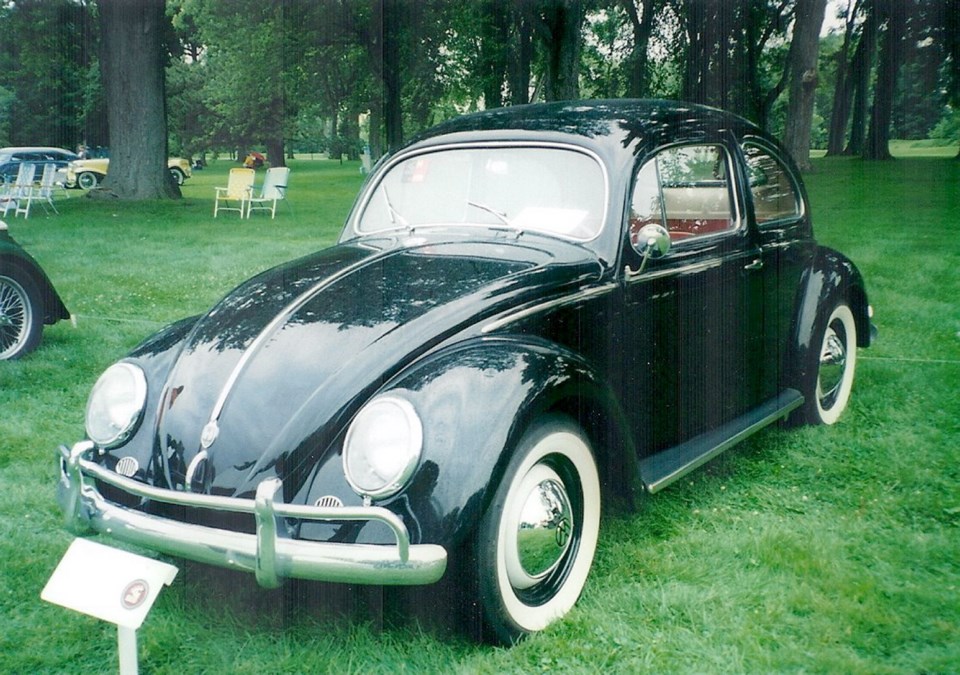Adolf Hitler became chancellor of Germany in 1933, and one of his first promises to the German people was for a reliable, economical (40 mpg), affordable family car suitable for cruising at 100 km/h on another of his promises, a limited-access high-speed highway system known as the autobahn.
Car enthusiast Hitler was an admirer of Henry Ford, and had been strongly influenced by what Ford had done for Americans’ mobility and freedom with his sturdy Model T.
Hitler engaged Ferdinand Porsche’s consulting engineering firm to design his “car for the people.” He wanted it called the KDF (Kraft durch Freude, or Strength Through Joy) but most began calling it simply the Volkswagen, or People’s Car, and the name stuck.
Porsche based the Volkswagen on a design his office had prepared in 1932 for NSU, which had abandoned it at the prototype stage.
Its air-cooled, horizontally opposed (flat), four-cylinder engine behind the rear axle drove the rear wheels through a four-speed manual transmission in which fourth gear was an overdrive.
Suspension was fully independent via torsion bars, and it had an aerodynamic, beetle-shaped, two-door sedan body.
Lacking an assembly facility, Porsche staff built the original cars in Porsche’s private garage at his home near Stuttgart. Three prototypes were ready by the fall of 1936.
The cars passed their 50,000-kilometre test, and although there were some problems, the design was judged to be basically sound.
In 1937, 30 more Volkswagens were completed and driven a total of 2.4 million test kilometres. Another 30 were built for propaganda purposes.
When Germany’s established motor manufacturers were unenthusiastic about producing Hitler’s people’s car, he ordered construction of a huge state-funded factory near Schloss (castle) Wolfsburg in the northern German state of Lower Saxony.
The Volkswagenwerk cornerstone was laid in May 1938. It was completed in the spring of 1939, but by this time it was apparent that Hitler had other priorities.
A small number of KdFs were produced before and during the Second World War, but plant production was mostly dedicated to military needs, including the VW-based Jeep-like Kubelwagen (“bucket car”) and four-wheel-drive amphibious version called the Schwimmwagen.
Although car production was limited, Hitler’s government established a layaway plan in which Germans paid for new Volkswagens in advance by buying savings stamps. Savers didn’t get their cars, prompting them to launch an 11-year postwar lawsuit that they finally settled successfully in 1961.
After the war, the VW plant, about two-thirds destroyed by bombing, was in the Allied-controlled British zone. Several automakers, among them Ford and Rootes, were offered the operation.
They saw an ugly, noisy little air-cooled bug-shaped vehicle and a shabby war-damaged plant. They totally overlooked the Beetle’s sound basic engineering and said no thanks, which must rank among the major business blunders of all time.
The British-controlled factory was serving as a truck repair facility when German workers and displaced persons started trickling back. They began repairing the plant and setting up production machinery that had been hidden. This was encouraged by the British, overseen by Major Ivan Hirst of the Royal Electrical and Mechanical Engineers.
Small-scale VW production soon began: 1,785 in 1945; 10,020 in ’46; and 8,987 in ’47. The cars were used by occupation forces and the post office.
Rebuilding and carmaking accelerated in 1948 when experienced German ex-Opel automotive engineer Heinrich (Heinz) Nordoff, ace production man and human dynamo, was placed in charge.
Nordhoff rallied the workforce, raised morale and pushed production from the fewer than 20,000 VWs built up to his arrival, to 500,000 by July 1953, one million by August 1955 and five million by December 1961.
North American sales began in 1949 when two cars arrived in the U.S. Volkswagen Canada was established in 1952 and began selling 1953 models.
Although the Beetle’s shape remained unchanged, there were constant mechanical improvements. Its inherent sturdiness and excellent parts and service network were backed by clever self-deprecating advertising by Doyle Dane Bernbach (“Think small”; “Did you ever wonder how the snowplow driver gets to work?”). The Volkswagen rose to the pinnacle of small-car sales during the 1950s and ’60s.
The Volkswagen Beetle went on to become one of the most popular single models in automotive history. On Feb. 15, 1972, the 15,007,034th Beetle was built, surpassing the legendary Ford Model T. When production ceased, more than 22 million had been built.
If one car could be called truly ubiquitous, it would be the original German Volkswagen Beetle. Over almost 70 years (the last one was built in Mexico in July 2003) it was assembled in four countries and sold in more than 140. It created so much goodwill that when Volkswagen introduced a modernized version in 1998, it also proved popular.



